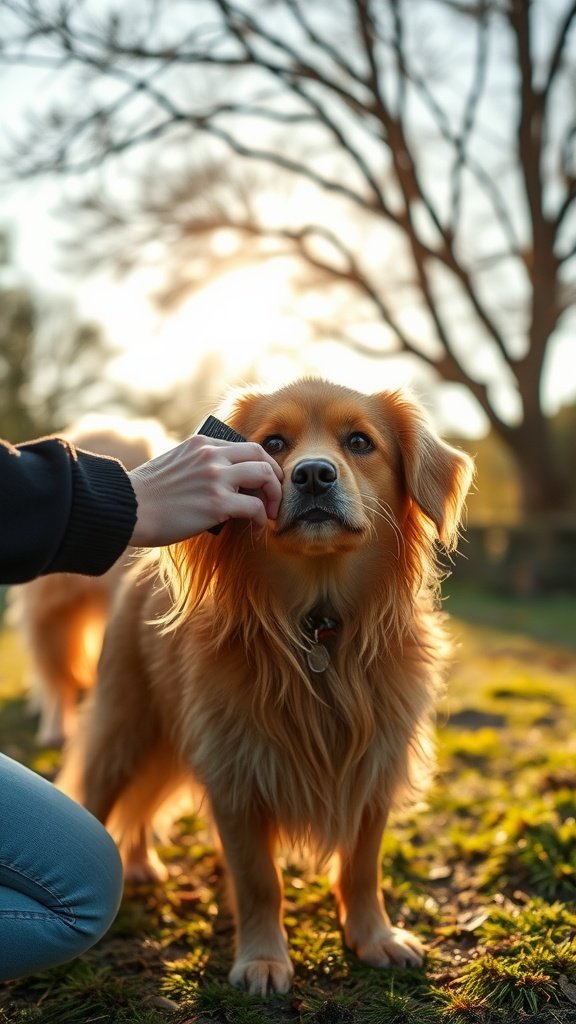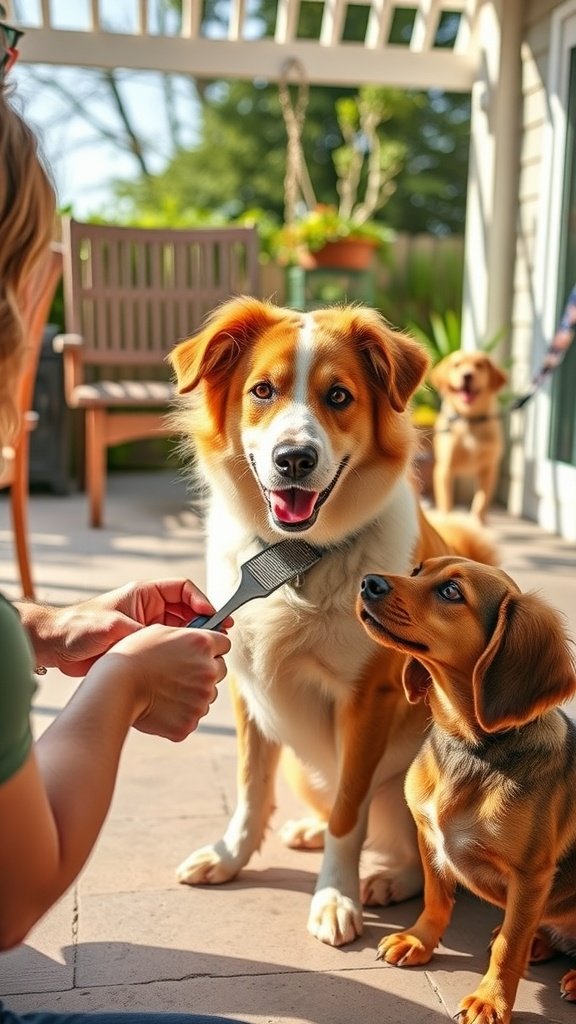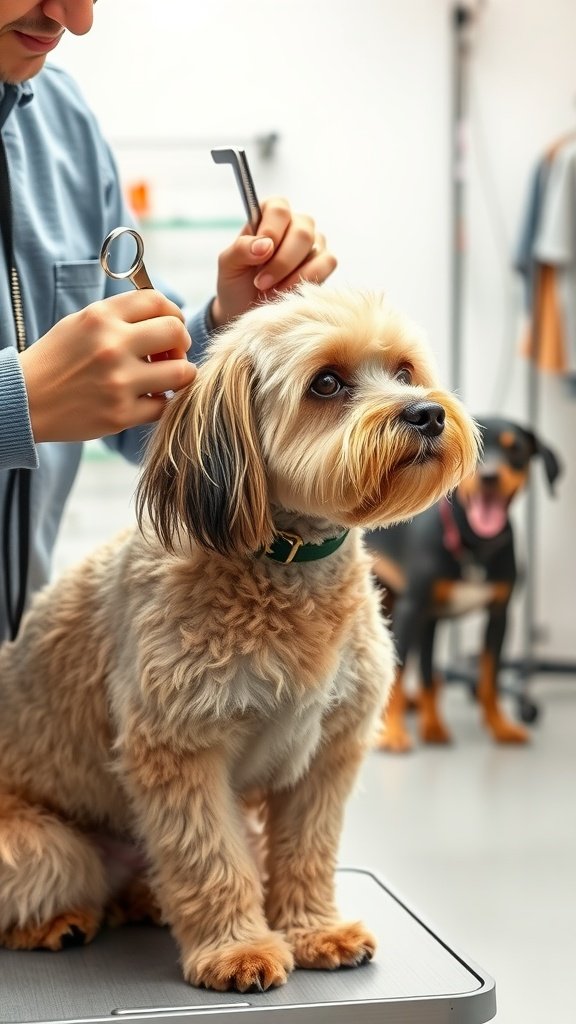
1. Understanding Dog Coat Types
1.1. Short Coat
-
Coat Length: Short coats generally range from 1/4 to 1 inch in length, giving the dog a sleek and smooth appearance. Some breeds might have slightly longer hair, but it still maintains a short and manageable length.
-
Coat Texture: The texture of short-coated dogs can vary from fine and soft to coarse and stiff. While they might not require the same level of maintenance as longer coats, they can still shed.
-
Examples: Breeds like Beagles, Boxers, French Bulldogs, and Chihuahuas are all short-coated dogs. While these dogs don’t require trimming as frequently as long-coated breeds, they still benefit from regular maintenance such as brushing and nail trimming.
1.2. Long Coat
-
Coat Length: Long-haired dogs often have coats that grow several inches or more, creating a flowing, luxurious look. The length of their coat can vary, but it typically reaches past the dog’s body and often extends well past the paws and tail.
-
Coat Texture: The texture of long coats can be silky, wavy, or straight. Some long-haired dogs, like the Shih Tzu, may have very silky hair, while others, such as the Afghan Hound, have more coarse and dense coats.
-
Examples: Breeds such as Shih Tzus, Yorkshire Terriers, and Afghan Hounds fall into this category. Long-haired dogs often need frequent grooming to maintain their beautiful appearance and prevent tangling and matting.
1.3. Curly Coat
-
Coat Length: Curly coats can vary from medium to long length. The curls are usually tightly wound and create a dense, springy texture. These coats often require a fair amount of maintenance to ensure that the curls stay neat and healthy.
-
Coat Texture: Curly coats are dense and can be either soft or wiry. These coats have a natural tendency to trap hair and dirt, so regular brushing is essential.
-
Examples: The Poodle, Portuguese Water Dog, and Curly-Coated Retriever are all breeds with curly coats. While curly coats don’t shed much, they do need regular trimming and grooming to keep them from becoming matted or tangled.
1.4. Double Coat
-
Coat Length: Double-coated dogs have two layers of fur: an outer, coarser layer, and an undercoat that is softer and denser. The outer coat helps protect the dog from environmental elements, while the undercoat acts as insulation, helping to regulate the dog’s body temperature.
-
Coat Texture: The outer coat is generally stiff and straight, while the undercoat is plush and soft. This type of coat can be quite thick, and the hair may shed heavily, particularly during seasonal changes.
-
Examples: Breeds like Siberian Huskies, Golden Retrievers, and German Shepherds are all double-coated dogs. These dogs shed heavily, especially during spring and fall, so regular grooming is essential to avoid matting and manage shedding.
1.5. Wire Coat
-
Coat Length: Wire coats typically range from medium to long, with a rough, wiry texture. The hair should not be soft, and it often stands up or has a shaggy appearance.
-
Coat Texture: The texture of wire coats is dense and harsh. This rough texture is characteristic of breeds that were originally bred for hunting and working purposes, as the coat offers protection from the elements and rough terrain.
-
Examples: Breeds like the Schnauzer, Border Terrier, and West Highland Terrier have wire coats. Wire-coated dogs require a special grooming technique called hand-stripping to maintain the coat’s texture and health.
2. Grooming by Coat Type
2.1. Short Coat
-
Trimming Techniques:
-
Tools: For short coats, you’ll want to use a clipper with a shorter blade (No. 10 or No. 15) for a close, even trim. Clippers are ideal for short hair, as they can provide a smooth, professional cut.
-
Trim Frequency: Short-coated dogs typically don’t need to be trimmed as often as long-haired dogs. A trim every 4 to 6 weeks is often enough, especially for areas like the paws, around the ears, and the tail. Short coats may also benefit from occasional trimming if the hair has grown too long or looks untidy.
-
Cut Length: While short-coated dogs don’t require major cuts, a tidy-up around the edges (such as paws, tail, and face) is often needed. For example, trimming around the ears and face can make a short-coated dog look sharp without altering the overall coat length.
-
Maintenance: These dogs generally shed year-round, so regular brushing helps reduce loose fur around the house. Brushing once a week with a slicker brush can help manage shedding and keep the coat shiny and healthy.
-
2.2. Long Coat
-
Trimming Techniques:
-
Tools: Long coats require a combination of clippers and scissors. Use clippers with longer blades (No. 7 or No. 5) for overall trimming and thinning shears for removing bulk without sacrificing length. Scissors are used for precise work, especially around the face, paws, and tail.
-
Trim Frequency: Depending on the dog’s coat and the owner’s preference, long coats should be trimmed every 6-8 weeks. If the owner prefers a well-maintained appearance, more frequent grooming may be necessary, particularly for dogs with coats that mat easily.
-
Cut Length: Long-haired dogs may have their coats kept at full length for a flowing, elegant look, or trimmed for a neater appearance. Some owners opt for styles like the “puppy cut” or “teddy bear cut,” which involve trimming the hair to a manageable length while still preserving the long, flowing look.
-
Maintenance: Long-haired dogs need regular brushing (at least 3-4 times a week) to prevent tangling and mats. Use a pin brush for silky coats and a slicker brush for coarser coats. It’s essential to focus on areas where mats can form, such as behind the ears, under the arms, and around the tail.
-
2.3. Curly Coat
-
Trimming Techniques:
-
Tools: Curly coats require special care. Use clippers (No. 10 or No. 7) to shape the coat, and thinning shears to remove bulk while keeping the curls intact. Always ensure that the clippers are kept clean and sharp to prevent pulling the coat.
-
Trim Frequency: A curly coat should be trimmed every 4 to 6 weeks to prevent matting. Because curly coats are more prone to tangling, trimming will help keep the coat neat and manageable.
-
Cut Length: Curly-haired dogs can have their hair kept shorter for easier maintenance, or it can be trimmed to a specific length based on the owner’s preference. Popular trims include the “Poodle cut” (often seen in show Poodles) or the “Cocker Spaniel cut,” which keeps curls under control while allowing some length.
-
Maintenance: Curly coats require more frequent brushing than most other coat types. A slicker brush works well for detangling, while a comb can help with stubborn knots. Brushing 3-4 times a week is recommended, and ensure the curls remain hydrated with a moisturizing spray or conditioner to avoid breakage.
-
2.4. Double Coat
-
Trimming Techniques:
-
Tools: A de-shedding rake and undercoat rake are must-have tools for double-coated dogs. These tools help you reach and remove the dense undercoat, which sheds heavily. For the outer coat, clippers with a medium blade (No. 7 or No. 5) can be used for trimming.
-
Trim Frequency: Double-coated dogs should be groomed every 6-8 weeks to manage shedding and prevent mats in the undercoat. However, during shedding seasons (spring and fall), they may require more frequent grooming.
-
Cut Length: Be cautious not to cut the outer coat too short, as it serves an important purpose in protecting the dog from the elements. Focus on trimming the undercoat to remove excess hair and reduce shedding.
-
Maintenance: Double-coated dogs require more extensive brushing to manage shedding. Brush the undercoat with an undercoat rake or pin brush at least 2-3 times a week. This will help to remove loose hairs and prevent mats from forming.
-
2.5. Wire Coat
-
Trimming Techniques:
-
Tools: Wire coats require a different approach. Hand-stripping is the recommended method for maintaining the coat’s texture. However, clippers can be used in some cases if the dog is not being shown and texture is not a primary concern. Wire coats also benefit from a comb with wider teeth.
-
Trim Frequency: Hand-stripping should be done every 3-4 months to maintain the rough texture and appearance. Some owners choose to trim wire-coated dogs more frequently to control length, especially around the paws and face.
-
Cut Length: The wire texture is important, so only trim the coat to shape it or remove unwanted bulk. Do not clip or shave wire coats, as this will ruin the rough texture and make it soft and floppy.
-
Maintenance: Regular brushing (at least once a week) helps to keep the wire coat clean and remove loose hair. Hand-stripping helps the coat shed naturally, but if clippers are used, they should be done with care to preserve the integrity of the coat.
-
3. Grooming Tips for Different Coat Types
3.1. Short-Coated Dogs
-
While they don’t require extensive grooming, short-coated dogs still benefit from regular brushing to remove dead hair and promote a shiny coat. Brushing once a week with a shedding brush or a slicker brush helps remove loose hairs and reduces shedding around the home.
-
Pay attention to trimming nails and cleaning ears regularly, as short coats often leave these areas exposed to dirt and debris. You may also need to clean the skin folds around the face and neck to prevent irritation.
3.2. Long-Coated Dogs
-
Long-haired dogs require consistent brushing to avoid tangles and mats. Use a detangling spray or conditioner if necessary to help work through knots. Focus on high-risk areas like behind the ears, under the legs, and around the tail, where mats tend to form more frequently.
-
Bathing should be done regularly (but not too often) to maintain cleanliness without stripping the coat of natural oils. Always dry thoroughly and consider using a blow dryer designed for dogs to keep the coat fluffy and manageable.
3.3. Curly-Coated Dogs
-
Curly-coated dogs require extra care to avoid matting. It’s important to brush the coat frequently to keep it tangle-free and well-moisturized. Using a leave-in conditioner after baths will help maintain curl definition and keep the coat from becoming dry.
-
A regular haircut will help avoid mats from forming, and trimming every few weeks will keep the curly coat looking fresh and healthy. Keep an eye on the skin underneath the curls, as it can often become irritated or moist if not groomed properly.
3.4. Double-Coated Dogs
-
Double-coated dogs require regular brushing, especially during shedding season. The undercoat should be combed out using a rake or pin brush to remove dead hairs and prevent mats.
-
These dogs should not be shaved, as it can affect their ability to regulate body temperature. Instead, trim the undercoat to reduce shedding and prevent the outer coat from becoming too heavy and matted.
3.5. Wire-Coated Dogs
-
Hand-stripping is the best way to maintain a wire coat, and it should be done with care to avoid pulling too hard or damaging the skin. Regular brushing will help remove loose hair and keep the coat healthy.
-
While wire-haired dogs don’t require frequent baths, keeping the coat clean is essential for its texture and appearance.
4. Specific Dog Grooming Styles
Teddy Bear Cut: A popular cut for Poodles, Bichon Frises, and other small to medium-sized breeds. It involves trimming the dog’s fur to about 1–2 inches long, creating a soft and round appearance.
Puppy Cut: A versatile cut that can be applied to long-coated dogs like the Shih Tzu or Cocker Spaniel. The hair is cut relatively short and uniform all over, giving the dog a neat, youthful look.
Lion Cut: Typically used for breeds like Poodles and some long-haired cats, the lion cut leaves the hair around the head and neck longer while the body is shaved short, resembling a lion’s mane.
Bikini Cut: Often used for breeds like Poodles and Shih Tzus, the bikini cut trims the body hair short while leaving the face, chest, and tail area longer, creating a “bikini” look.
5. Grooming Tools You’ll Need
Clippers: Invest in high-quality clippers that are suitable for your dog’s coat type. They should be quiet, efficient, and easy to clean.
Scissors: Use sharp grooming scissors for precision trimming around sensitive areas like the face, paws, and tail.
Thinning Shears: These are perfect for thinning out dense coats and blending different areas of the dog’s coat to create a seamless finish.
Brushes:
-
Slicker Brush: Great for brushing out tangles in long, curly, and double coats.
-
Pin Brush: Ideal for long-haired dogs to detangle their coats gently.
-
Undercoat Rake: Essential for double-coated dogs to remove excess undercoat fur.
-
Bristle Brush: Suitable for short-haired dogs to help remove loose hairs and smooth out the coat.
6. Common Grooming Mistakes to Avoid
Cutting Too Short: For some breeds, cutting the coat too short can compromise their protection against the elements, particularly for double-coated breeds. Always consider the dog’s natural coat structure before making significant cuts.
Not Brushing Before Cutting: Brushing before cutting is critical to remove mats and tangles. If the coat is not prepped properly, cutting can lead to uneven results and may even cause discomfort to the dog.
Using the Wrong Tools: Make sure to choose the right clippers, scissors, and brushes for your dog’s coat type. Using human grooming tools can cause discomfort and lead to poor grooming outcomes.
Conclusion
Each dog has its own unique grooming requirements, depending on its breed and coat type. Understanding the needs of your dog’s specific coat type—whether it’s short, long, curly, double, or wire—will allow you to groom more effectively and keep your dog looking and feeling its best. With the right tools and techniques, you can achieve a clean, healthy, and beautiful coat while also preventing skin issues, matting, and excessive shedding.

